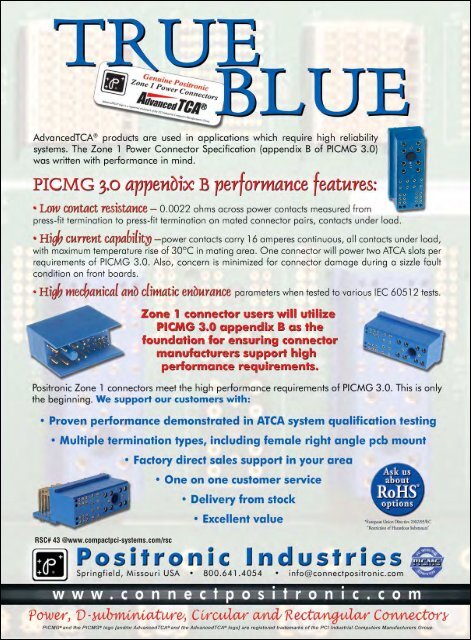CompactPCI and AdvancedTCA Systems - OpenSystems Media
CompactPCI and AdvancedTCA Systems - OpenSystems Media CompactPCI and AdvancedTCA Systems - OpenSystems Media
APPLICATIONMONITORING AND CONTROLUsing remote upgrades to increase revenue anddecrease costs in wireless base stationsBy David GambaThe 3G rollout is now in full force and will be drivingnew data service requirements that will enable wirelessoperators to stem their ARPU decline. David arguesthat base station designs will need to offer moreflexibility to meet the increasingly technically complexrequirements for delivering next generation data services.Though the 3G rollout has been delayed from original prognostications,the transition to 3G is moving very quickly now. Accordingto iSuppli, 2004 marked the last year that any infrastructure dollarswill be spent installing a 2G network, and 2006 will be the last yearfor any investment (and less than five percent at that) for a 2.5Gnetwork installation. The transition to 3G means associated higherspeed standards can now be supported. The time is ripe for mobileoperators to capitalize on the latest standards and quickly beginoffering higher revenue generating data services to their customers.To this end, these operators can take advantage of a new flexiblebase station technology based on Field Programmable Gate Arrays(FPGAs) that enables in-field upgrades to support the latest industrystandards and handset features. This flexible FPGA technologycan also provide innovative ways to reduce operators’ costs, helpingincrease profitability.Wireless network evolutionAs the Third Generation Partnership Project (3GPP) standardsmove from the 2G and 2.5G based standards of CDMA,GSM, GPRS, and TDMA to the 3G based standards of EDGE,CDMA2000, 1xDO-EV, and W-CMDA, new enriched data servicesand advanced functionality will be available. The enhancedrevenue generating services will include messaging, photo transmission,e-mail, Internet access, motion video transmission, ande-commerce. What’s more, advanced features such as Quality-of-Service (QoS) guarantees and bandwidth-on-demand adjustmentcapabilities will supplement these services, giving rise to morecombinations of revenue generating packages for the wirelessoperators.Reversing the trend of declining user revenueThe new data services and feature offerings will serve as a boonto wireless operators as they can now stabilize and reverse theireroding subscriber ARPU (see Table 1). This is especially importantin regions with very high penetration rates such as WesternEurope (79 percent), Japan (69 percent), and North America(58 percent), where new subscribers will not provide the growthnecessary to drive revenues. In addition, by offering new dataservices and advanced features, wireless operators may be ableto reduce their churn rate (especially in regions dominated byprepaid subscribers who do not have monthly contracts) by offeringunique pricing packages.Addressing technical requirements using remoteupgradesTo enable these advanced data services offerings, the big questionfacing the wireless infrastructure industry is: What is thebest way to deliver flexible, cost-effective solution deploymentsto meet these requirements? Given that the 3GPP standards arestill evolving and that distinct geographical variations will existfor quite some time, wireless base station designs are incorporatingmore programmable technologies such as FPGAs intheir designs. For example, the 3GPP Release 5 added a featurecalled High Speed Downlink Packet Access (HSDPA) as a newUniversal Mobile Telecommunications System (UMTS) requirementin its baseband processing specification for Wideband CodeDivision Multiple Access (W-CDMA). This new feature enablesbase stations to transmit data to the handset units at a peak rate of14.4 Mbps, a sevenfold increase over the previous downlink ratesupported by Release 4 (2 Mbps). This performance increaseenables more advanced data services that will help wirelessoperators raise ARPU. Adding HSDPA to the 3GPP standardrequired upgrading deployed base station units. Operators easilyupgraded some base station designs by implementing an infieldupgrade to the FPGAs on the baseband card to add supportfor the HSPDA feature. Other designs, using inflexible ASICs,required either lengthy redesigns and verification efforts beforerespinning a new ASIC or a complementary device and basebandboard redesign to support this new feature.The HSDPA support issue offers a perfect example of how FPGAdevices speed time-to-market product delivery and enable flexibilityfor field upgrades to support future standard changes oradditions. Turning to FPGAs represents a long overdue shiftaway from using ASIC technology, which does not offer the abilityto future-proof deployments against standards changes or theflexibility to support geographic customization.Average Revenue Per User (ARPU)1996 1997 1998 1999 2000 2001 2002 2003 2004 2005 2006Voice $82 $66 $54 $45 $39 $35 $33 $32 $31 $30 $29Data - - - - $1 $2 $4 $6 $8 $10 $13Total $82 $66 $54 $45 $40 $37 $37 $38 $39 $40 $42Table 142 / CompactPCI and AdvancedTCA Systems / June 2005
RSC# 43 @www.compactpci-systems.com/rscCompactPCI and AdvancedTCA Systems / June 2005 / 43
- Page 3: RSC# 3 @www.compactpci-systems.com/
- Page 7 and 8: RSC# 7 @www.compactpci-systems.com/
- Page 9: CompactPCI and AdvancedTCA Systems
- Page 13 and 14: 2. Global walking: Communicationsan
- Page 15 and 16: RSC# 15 @www.compactpci-systems.com
- Page 17 and 18: TECHNOLOGY IN EUROPETECHNOLOGY IN E
- Page 19 and 20: RSC# 19 @www.compactpci-systems.com
- Page 21 and 22: Figure 2technologies with a redesig
- Page 23 and 24: SPECIAL7447A processors at differen
- Page 25 and 26: System demandsUAV platforms must ha
- Page 27 and 28: SPECIALHIGH-END EMBEDDED COMPUTINGp
- Page 29 and 30: RSC# 29 @www.compactpci-systems.com
- Page 31 and 32: Consumer pressuresService providers
- Page 33 and 34: RSC# 33 @www.compactpci-systems.com
- Page 35 and 36: SPECIALHIGH-END EMBEDDED COMPUTINGo
- Page 37 and 38: oth the host bus and the cabled exp
- Page 39 and 40: SPECIALHIGH-END EMBEDDED COMPUTINGS
- Page 41: RSC# 41 @www.compactpci-systems.com
- Page 45 and 46: APPLICATIONFor base stations implem
- Page 47 and 48: RSC# 47 @www.compactpci-systems.com
- Page 49 and 50: compatibility with legacy backplane
- Page 51 and 52: PRODUCT GUIDESBCProcessorFeaturesPr
- Page 53 and 54: PRODUCT GUIDESBCProcessorFeaturesPr
- Page 55 and 56: PRODUCT GUIDESBCProcessorFeaturesPr
- Page 57 and 58: RSC# 57 @www.compactpci-systems.com
- Page 59 and 60: NEW PRODUCTSNEW PRODUCTSBy Chad Lum
- Page 61 and 62: • Withstands over 15 g’s of sho
- Page 63 and 64: RSC# 63 @www.compactpci-systems.com
- Page 65 and 66: nel is specifically tailored toward
- Page 67 and 68: RSC# 67 @www.compactpci-systems.com
RSC# 43 @www.compactpci-systems.com/rsc<strong>CompactPCI</strong> <strong>and</strong> <strong>AdvancedTCA</strong> <strong>Systems</strong> / June 2005 / 43



